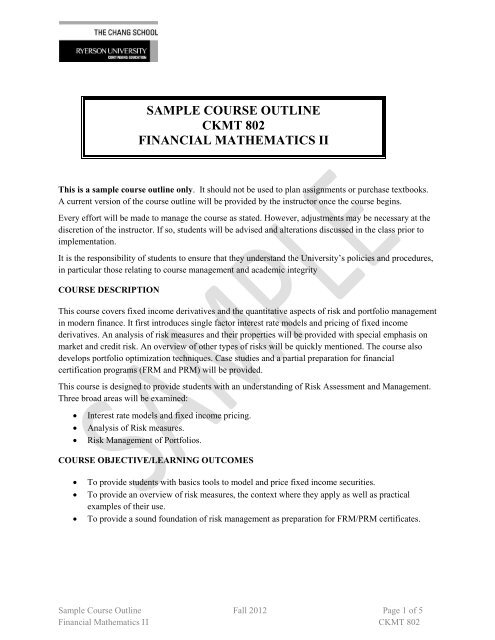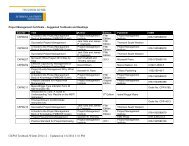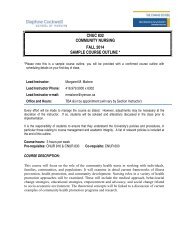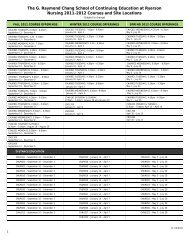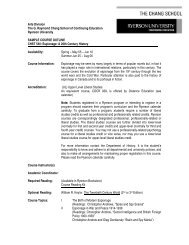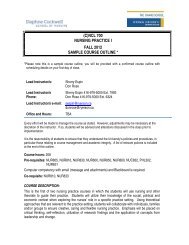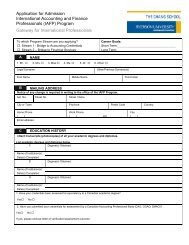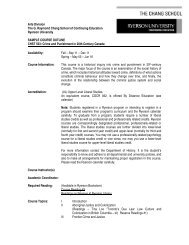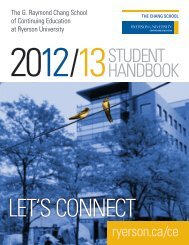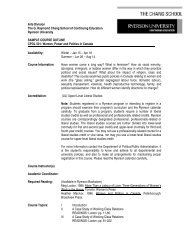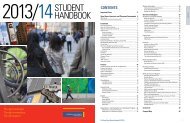sample course outline ckmt 802 financial mathematics ii
sample course outline ckmt 802 financial mathematics ii
sample course outline ckmt 802 financial mathematics ii
Create successful ePaper yourself
Turn your PDF publications into a flip-book with our unique Google optimized e-Paper software.
SAMPLE COURSE OUTLINE<br />
CKMT <strong>802</strong><br />
FINANCIAL MATHEMATICS II<br />
This is a <strong>sample</strong> <strong>course</strong> <strong>outline</strong> only. It should not be used to plan assignments or purchase textbooks.<br />
A current version of the <strong>course</strong> <strong>outline</strong> will be provided by the instructor once the <strong>course</strong> begins.<br />
Every effort will be made to manage the <strong>course</strong> as stated. However, adjustments may be necessary at the<br />
discretion of the instructor. If so, students will be advised and alterations discussed in the class prior to<br />
implementation.<br />
It is the responsibility of students to ensure that they understand the University’s policies and procedures,<br />
in particular those relating to <strong>course</strong> management and academic integrity<br />
COURSE DESCRIPTION<br />
This <strong>course</strong> covers fixed income derivatives and the quantitative aspects of risk and portfolio management<br />
in modern finance. It first introduces single factor interest rate models and pricing of fixed income<br />
derivatives. An analysis of risk measures and their properties will be provided with special emphasis on<br />
market and credit risk. An overview of other types of risks will be quickly mentioned. The <strong>course</strong> also<br />
develops portfolio optimization techniques. Case studies and a partial preparation for <strong>financial</strong><br />
certification programs (FRM and PRM) will be provided.<br />
This <strong>course</strong> is designed to provide students with an understanding of Risk Assessment and Management.<br />
Three broad areas will be examined:<br />
<br />
<br />
<br />
Interest rate models and fixed income pricing.<br />
Analysis of Risk measures.<br />
Risk Management of Portfolios.<br />
COURSE OBJECTIVE/LEARNING OUTCOMES<br />
<br />
<br />
<br />
To provide students with basics tools to model and price fixed income securities.<br />
To provide an overview of risk measures, the context where they apply as well as practical<br />
examples of their use.<br />
To provide a sound foundation of risk management as preparation for FRM/PRM certificates.<br />
Sample Course Outline Fall 2012 Page 1 of 5<br />
Financial Mathematics I I CKMT <strong>802</strong>
CORE TOPICS:<br />
Interest rate Modeling and Pricing: Fixed income markets are the largest capital markets in the world.<br />
They involve a large and diverse set of participants including governments, banks, private and<br />
institutional investors. This part of the <strong>course</strong> has two objectives, first is to provide students with the<br />
theoretical framework to deal with the analysis of fixed income securities and derivatives. Second to use<br />
this theory in the case of a simple model, the Vasicek model.<br />
Risk Measures: Risk measures are defined mainly in the context of Maket and Credit scenarios. They are<br />
used to determine the amount of an asset to be kept in reserve in order to make the risks taken by <strong>financial</strong><br />
institutions, such as banks and insurance companies, acceptable to the regulator. Particular emphasis will<br />
be placed on standard measures like variance and Value-at-Risk as well as convex and coherent risk<br />
measurement like Expected Shortfall.<br />
Portfolio Risk Management: The concept of risk and return, in particular expected value and volatility of<br />
a portfolio will be provided. Optimization problems associate with portfolio management like finding<br />
efficient portfolios, efficient frontier, with and without risky assets will be studied in detail.<br />
Financial Data: Hands on applications will be presented using toy <strong>financial</strong> data in order to establish a<br />
foundation for the use of Matlab in Financial Mathematics.<br />
TEXTBOOK AND READING LISTS<br />
This is a <strong>sample</strong> <strong>course</strong> <strong>outline</strong> only. It should not be used to purchase textbooks. A current version<br />
of the <strong>course</strong> <strong>outline</strong> will be provided by the instructor once the <strong>course</strong> begins.<br />
Required Text:<br />
(1) Financial Risk Manager Handbook, Jorion, Ph. John Wiley & Sons, Inc. Second Edition<br />
(2) Investment Science. Luenberger D.G. Oxford University Press. 2nd edition(1998)<br />
Readings and Related Material:<br />
Bond Markets, Analysis, And Strategies, Pearson. Prentice Hall, 6th edition, Frank J. Fabozzi.(2007)<br />
COURSE STRUCTURE AND ORGANIZATION<br />
This is a <strong>sample</strong> <strong>course</strong> <strong>outline</strong> only. A current version of the <strong>course</strong> <strong>outline</strong> will be provided by the<br />
instructor once the <strong>course</strong> begins.<br />
Sample Course Outline Fall 2012 Page 2 of 5<br />
Financial Mathematics I I CKMT <strong>802</strong>
Each class will consist of two components: A lecture that covers theory and an overview of practical<br />
applications of concepts and a demonstration of the concepts in <strong>financial</strong> applications.<br />
Week Topic Details<br />
1 Interest rate Models.<br />
Chapter 7 (1): Overview of Single Factor models.<br />
2 Pricing fixed Income.<br />
3 Market Risk models<br />
Pricing fixed income securities with Vasicek Model. Non<br />
defaultable vanilla bonds pricing.<br />
Chapter 11 (1): Methods for Value-at-Risk calculation. Delta-<br />
Gamma approach for portfolio VaR.<br />
4<br />
Coherent risk measures.<br />
Assignment 1<br />
Expected Shortfall. Stress scenario and back testing<br />
techniques.<br />
Interest rate Pricing.<br />
5 Credit Models.<br />
Part 4 (1): Structural models and Reduced-form models.<br />
6<br />
Credit Risk Management.<br />
Assignment 1 Due<br />
Default probabilities and recovery models.<br />
-<br />
7 Credit Rating Credit portfolio losses and credit VaR. Rating methods.<br />
8<br />
Other types of risk<br />
Assignment 2<br />
Chapter 24 (1): Operational Risk. Liquidity Risk.<br />
Risk Measures.<br />
9 Portfolio Management<br />
Chapter 6 (2): Expected Return and Volatility of a portfolio.<br />
10 Case Study 2<br />
Mean-Variance Portfolio optimization (MVPO): risky assets.<br />
11 Mapping Population MVPO: risky and risk-free assets. Value at Risk Portfolio<br />
Sample Course Outline Fall 2012 Page 3 of 5<br />
Financial Mathematics I I CKMT <strong>802</strong>
Projections<br />
Assignment 3<br />
Assignment 2 Due<br />
Optimization.<br />
Portfolio Optimization.<br />
-<br />
12 Capital Asset Pricing<br />
Model.<br />
Chapter 7 (2): Capital Asset Pricing Model.<br />
13 Exam Exam: Multiple Choice/Short Answer<br />
METHOD AND SCHEDULE OF STUDENT EVALUATION<br />
This is a <strong>sample</strong> <strong>course</strong> <strong>outline</strong> only. It should not be used to plan assignments. A current version of the<br />
<strong>course</strong> <strong>outline</strong> will be provided by the instructor once the <strong>course</strong> begins.<br />
3 assignments worth 20% each 60%<br />
Final examination (non-lab) 40%<br />
Total 100%<br />
Lab Assignments (graded):<br />
Assignment 1: Pricing of fixed income derivatives under Vasicek model.<br />
Assignment 2: Calculation of Risk Measures in several scenarios.<br />
Assignment 3: Mean Variance Portfolio allocation with risky and non-risky assets.<br />
Assignments are due at the beginning of the evening set out in the schedule above. The instructor must<br />
approve any extension prior to the due date. No lab assignment submission will be accepted for<br />
grading once graded labs have been returned to students, normally at the next class after being<br />
handed in. Work not handed in during class may be e-mailed to …@ryerson.ca.<br />
MISSED TERM WORK OR EXAMINATIONS<br />
Students are expected to complete all assignments, tests, and exams within the time frames and by the<br />
dates indicated in this <strong>outline</strong>. Exemption or deferral of an assignment, term test, or final examination is<br />
only permitted for a medical or personal emergency or due to religious observance. The instructor must<br />
be notified by e-mail prior to the due date or test/exam date, and the appropriate documentation must be<br />
submitted. For absence on medical grounds, an official student medical certificate, downloaded from the<br />
Ryerson website at http://www.ryerson.ca/senate/forms/medical.pdf or picked up from The Chang<br />
School at Heaslip House, 297 Victoria St., Main Floor, must be provided. For absence due to religious<br />
Sample Course Outline Fall 2012 Page 4 of 5<br />
Financial Mathematics I I CKMT <strong>802</strong>
observance, visit http://www.ryerson.ca/senate/forms/relobservforminstr.pdf to obtain and submit the<br />
required form.<br />
PLAGIARISM<br />
The Ryerson Student Code of Academic Conduct defines plagiarism and the sanctions against students<br />
who plagiarize. All Chang School students are strongly encouraged to go to the academic integrity<br />
website at www.ryerson.ca/academicintegrity and complete the tutorial on plagiarism.<br />
ACADEMIC INTEGRITY<br />
Ryerson University and The Chang School are committed to the principles of academic integrity as<br />
<strong>outline</strong>d in the Student code of Academic conduct. Students are strongly encouraged to review the student<br />
guide to academic integrity, including penalties for misconduct, on the academic integrity website at<br />
www.ryerson.ca/academic integrity and the Student code of Academic conduct at<br />
www.ryerson.ca/senate/policies.<br />
RYERSON STUDENT EMAIL<br />
All students in full and part-time graduate and undergraduate degree programs and all continuing<br />
education students are required to activate and maintain their Ryerson online identity at<br />
www.ryerson.ca/accounts in order to regularly access Ryerson’s E-mail (Rmail), RAMSS, my.ryerson.ca<br />
portal and learning system, and other systems by which they will receive official University<br />
communications.<br />
COURSE REPEATS:<br />
Senate GPA policy prevents students from taking a <strong>course</strong> more than three times. For complete GPA<br />
policy see policy no. 46 at www.ryerson.ca/senate/policies.<br />
RYERSON ACADEMIC POLICIES<br />
For more information on Ryerson’s academic policies, visit the Senate website at www.ryerson.ca/senate.<br />
Course Management Policy No. 145<br />
Student Code of Academic conduct No. 60<br />
Student code of non-Academic Conduct No. 61<br />
Examination Policy No. 135<br />
Policy on Grading, Promotion, and Academic Standing Policy No. 46<br />
Undergraduate Academic consideration and Appeals Policy No. 134<br />
Accommodation of Student Religious Observance Obligations Policy no. 150<br />
Sample Course Outline Fall 2012 Page 5 of 5<br />
Financial Mathematics I I CKMT <strong>802</strong>


